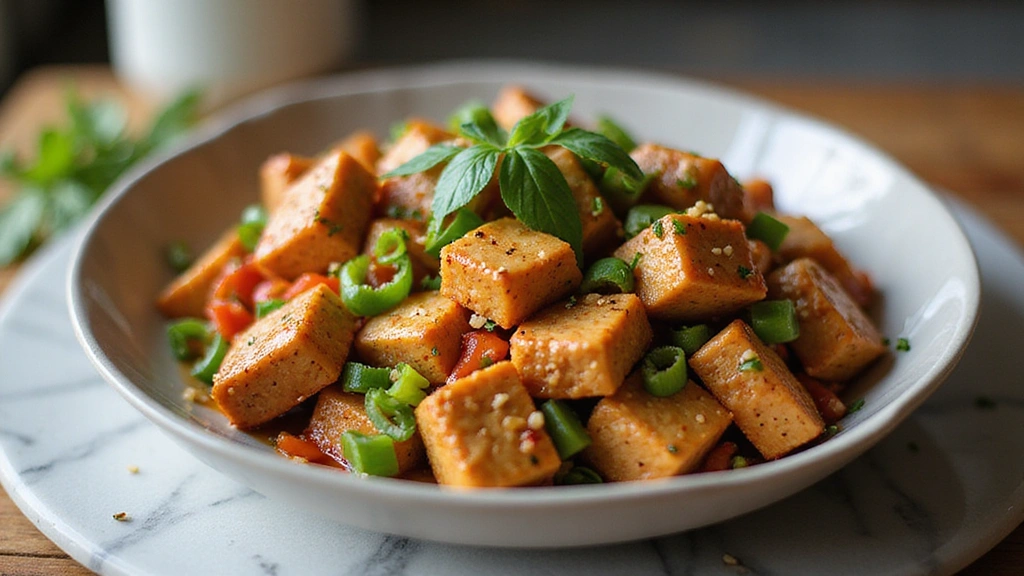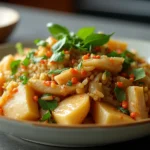This easy Chinese Tofu Stir Fry is a delightful fusion of vibrant vegetables and protein-packed tofu that promises satisfaction in every bite.
The savory sauce, combined with the crispness of fresh produce, creates a satisfying and healthy meal that’s incredibly quick to prepare.
I first fell in love with this dish during a visit to a bustling market in Beijing, where the aromas of sizzling stir-fries filled the air.
Whether you’re looking to impress at a dinner party or simply want a nourishing weeknight meal, this recipe is sure to deliver both flavor and nutrition.
The History and Cultural Significance
• Chinese Tofu Stir Fry traces its origins to ancient China, where tofu was first developed as a nutritious food source around 2000 years ago.
• The dish evolved over decades as stir-frying became a popular cooking technique, allowing for quick and healthy meal preparation.
• In Chinese culture, stir-fried dishes are often served during family gatherings and celebrations, symbolizing harmony and balance.
• While many variations exist across different regions, the authentic version maintains a focus on fresh ingredients and balanced flavors that set it apart from imitations.
Recipe Overview
Nutritional Information (per serving)
Ingredients
Essential Equipment Guide
Wok: A wok is essential for achieving the high heat necessary for stir-frying. Its shape allows for even cooking and quick tossing of ingredients. If you don’t have a wok, a large skillet can serve as an alternative, but ensure it has a heavy bottom for optimal heat distribution.
Spatula: A wide spatula is crucial for flipping and stirring the ingredients without breaking them apart. Look for one made from silicone or wood to avoid scratching your cookware.
Cutting Board: A sturdy cutting board is important for safely chopping vegetables and tofu. Opt for a non-slip board to ensure stability while cutting.
Preparation Methods
Pressing Tofu: Pressing tofu removes excess moisture, which allows it to absorb flavors better and achieve a crispy texture when cooked. Wrap the tofu in a clean kitchen towel and place a heavy object on top for at least 15 minutes.
Julienning Vegetables: Julienning involves cutting vegetables into thin matchstick shapes, which ensures even cooking and enhances presentation. Use a sharp knife and a steady hand for best results.
Stir-Frying: Stir-frying is a high-heat cooking method that cooks food quickly while retaining its nutrients and crunch. Preheat your wok or skillet until it’s very hot, and work in small batches to avoid steaming the ingredients.
Step 1: Prepare Tofu
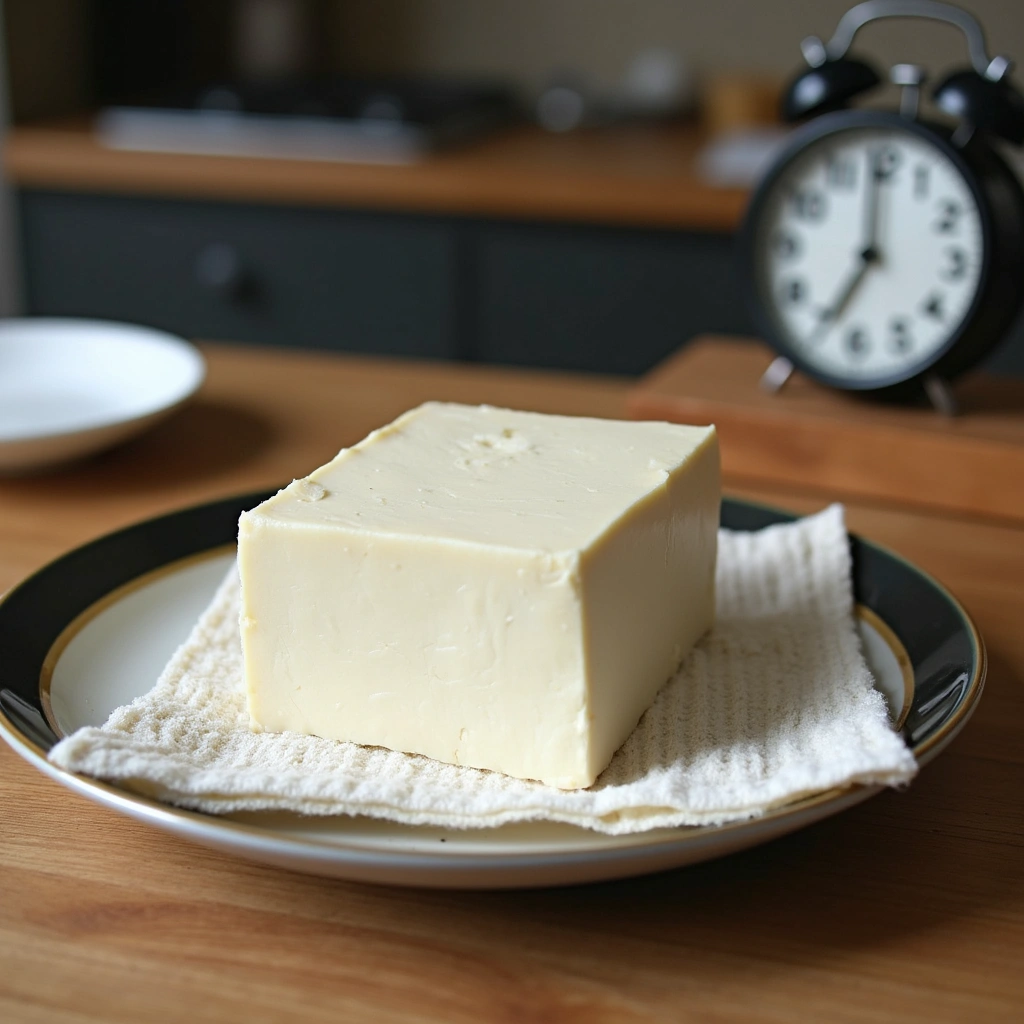
Begin by pressing the tofu to remove excess moisture.
Wrap the tofu block in a clean kitchen towel and place a heavy object on top.
Let it sit for about 15 minutes to achieve the best texture.
Once pressed, cut the tofu into 1-inch cubes for even cooking.
Step 2: Chop Vegetables
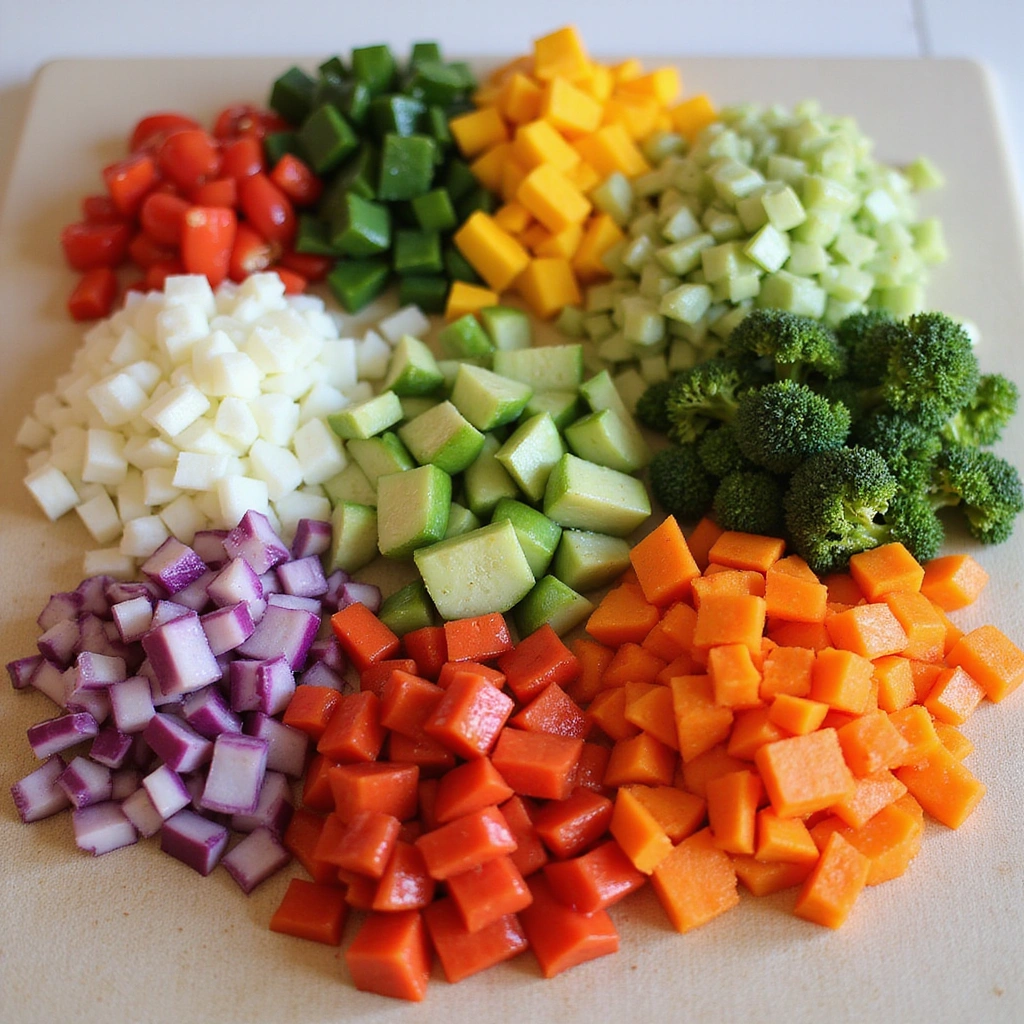
Wash and prepare all vegetables by chopping them into uniform sizes.
Slice the bell pepper, julienne the carrot, and cut the broccoli into small florets.
Ensure even sizes for uniform cooking.
Set all prepared vegetables aside for easy access during cooking.
Step 3: Make the Sauce

In a small bowl, combine soy sauce, sesame oil, cornstarch, and water.
Whisk until the cornstarch is completely dissolved.
This mixture will thicken and coat the stir-fry beautifully.
Set the sauce aside until ready to use.
Step 4: Heat the Wok

Place your wok over high heat and let it preheat for a couple of minutes.
You want the wok to be hot enough that water droplets sizzle upon contact.
This ensures a good sear on the tofu and vegetables.
Add the vegetable oil and swirl to coat the bottom of the wok.
Step 5: Cook the Tofu

Carefully add the cubed tofu to the hot wok in a single layer.
Let it cook undisturbed for about 3-4 minutes until golden brown.
Flip the tofu cubes to brown on all sides, ensuring they are crispy.
Once done, remove the tofu and set it aside on a plate.
Step 6: Stir-Fry Vegetables
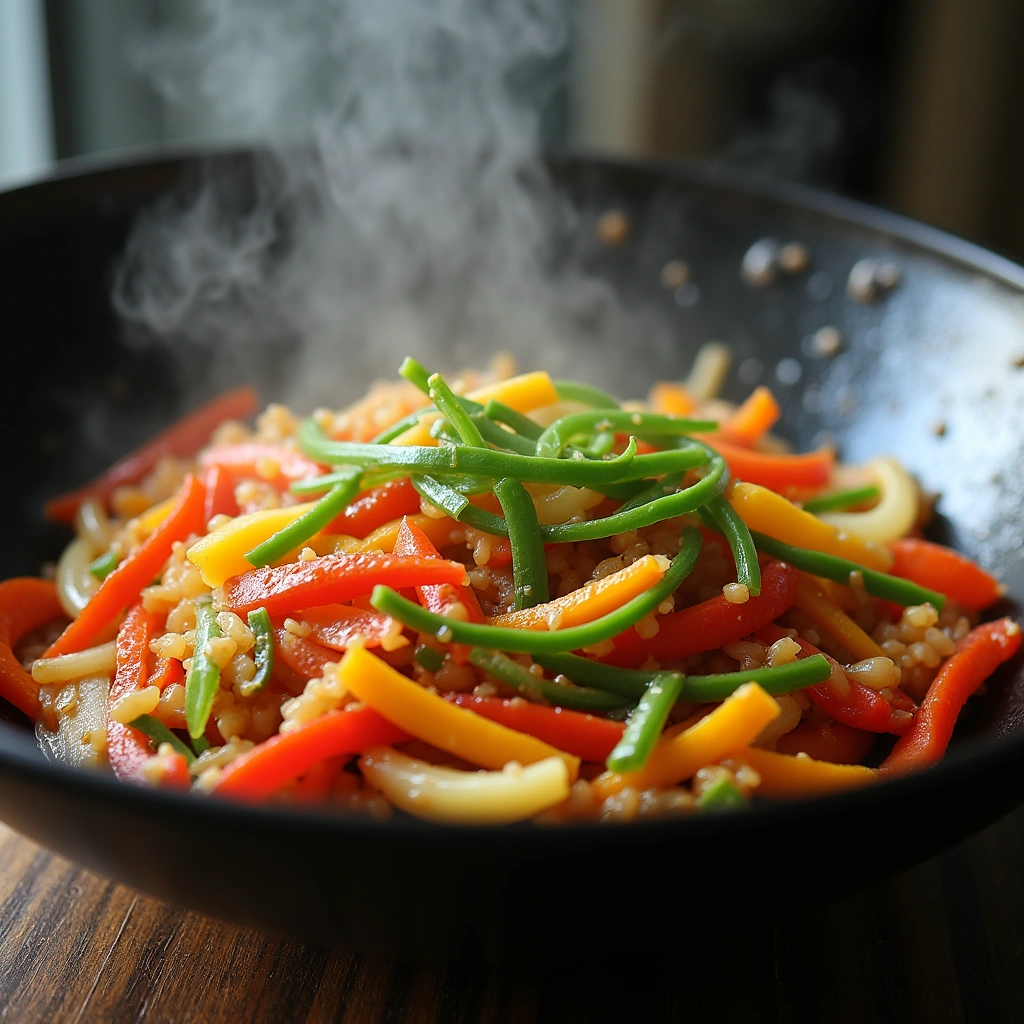
In the same wok, add the chopped garlic and ginger first, stirring quickly to avoid burning.
Then, add the sliced bell pepper, carrot, broccoli, and snap peas.
Stir-fry for about 3-4 minutes until they are vibrant and just tender.
Make sure to keep the vegetables moving for even cooking.
Step 7: Combine Ingredients

Add the cooked tofu back into the wok with the vegetables.
Pour the prepared sauce over the stir-fry, tossing everything to coat evenly.
Cook for an additional 2-3 minutes until the sauce thickens slightly.
Taste and adjust seasoning if necessary, adding more soy sauce if desired.
Step 8: Serve and Enjoy
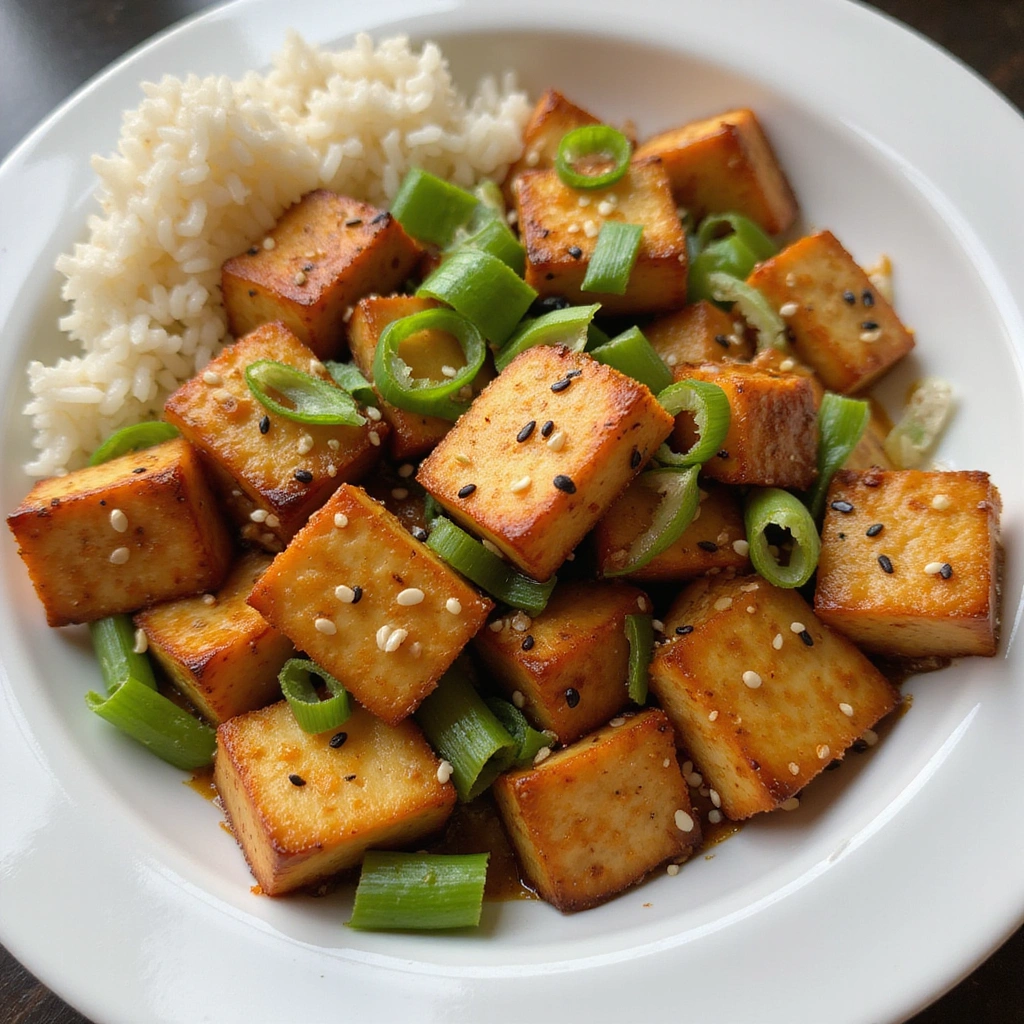
Remove the wok from heat and transfer the stir-fry to a serving platter.
Garnish with sesame seeds and sliced green onions for added flavor and texture.
Serve immediately with steamed rice or noodles.
Enjoy your healthy, protein-packed Chinese Tofu Stir Fry!
Critical Timing and Temperature Guide
Tofu Cooking: Cook the tofu for 3-4 minutes per side until golden brown. Look for a crisp exterior and firm texture. Avoid overcrowding the pan, which can lead to steaming instead of frying.
Vegetable Stir-Frying: Stir-fry vegetables for 3-4 minutes until tender-crisp. They should be vibrant and slightly tender but still have a bite. Watch carefully not to overcook, which can result in a mushy texture.
Final Sauce Integration: Allow the sauce to thicken for 2-3 minutes after adding it to the stir-fry. A glossy finish indicates readiness. Stir continuously to prevent sticking.
Pro Tips for Chinese Tofu Stir Fry Recipe Healthy And Protein Packed
• Ingredient Selection: Choose organic, non-GMO tofu for the best flavor and texture. Fresh vegetables enhance the taste and nutritional value.
• Preparation Secret: Marinating the tofu in a bit of soy sauce before cooking can infuse it with additional flavor.
• Temperature Management: Ensure your wok is extremely hot before adding ingredients; this helps achieve that restaurant-quality sear.
• Texture Enhancement: For extra crispy tofu, try coating it lightly with cornstarch before frying.
• Flavor Layering: Add a splash of rice vinegar or lime juice at the end of cooking for a bright finish.
• Make-Ahead Strategies: Prep the vegetables and sauce a day in advance to save time on busy weeknights.
• Restaurant-Quality Finishing Touches: Drizzle with additional sesame oil or sprinkle with toasted sesame seeds before serving.
• Equipment Optimization: Use a well-seasoned wok for non-stick performance; if you don’t have one, a non-stick skillet will work.
Troubleshooting Common Issues
• Tofu Too Soft: This often happens when the tofu isn’t pressed enough. Ensure you press it for at least 15 minutes to remove excess moisture for optimal texture.
• Vegetables Overcooked: If vegetables become mushy, reduce cooking time. Stir-fry at high heat and keep them moving to retain crunch.
• Flavor Lacks Depth: If the dish tastes flat, add a splash of soy sauce or a sprinkle of salt to enhance the flavors. Fresh herbs can also brighten the taste.
• Sauce Too Thick: If your sauce thickens too much, add a little water to loosen it up during cooking. Stir continuously to incorporate.
• Burnt Garlic or Ginger: To prevent burning, add garlic and ginger after the oil is hot but before the vegetables. Stir quickly to prevent them from sitting too long.
Variations and Regional Differences
• Szechuan Style: This variation features Szechuan peppercorns and additional heat from chili oil, giving it a spicy twist.
• Cantonese Style: Often includes a variety of seafood and a lighter sauce made with oyster sauce for a richer flavor.
• Vegetarian Version: Replace tofu with seitan or tempeh for a different protein source.
• Modern Interpretations: Incorporate quinoa or brown rice into the stir-fry for a contemporary, health-focused twist.
Food Science Behind the Recipe
• Maillard Reaction: This browning process occurs when proteins in tofu are heated, creating complex flavors and a desirable texture. Understanding this helps you achieve perfect tofu.
• Emulsification: The sauce thickens when cornstarch is heated, creating a glossy coating that adheres to the ingredients. This enhances flavor delivery with each bite.
• Starch Gelatinization: When cornstarch is mixed with liquid and heated, it absorbs water and swells, thickening the sauce and adding body to your stir-fry.
Frequently Asked Questions
What’s the most common mistake people make when preparing Chinese Tofu Stir Fry? The most frequent mistake is not pressing the tofu enough, which leads to a soggy texture. Always press your tofu to ensure it’s firm and able to absorb flavors.
Can I prepare components of this dish in advance? Yes, you can chop vegetables and prepare the sauce a day ahead. Store vegetables in airtight containers in the fridge and the sauce in a sealed jar.
How do I adapt this recipe for dietary restrictions? For gluten-free needs, use tamari instead of soy sauce. You can also swap out tofu for chickpeas or another preferred protein.
What’s the best way to store and reheat leftovers? Store leftovers in an airtight container in the fridge for up to 3 days. Reheat in a pan over medium heat until warmed through, adding a splash of water if needed to prevent sticking.
Can I freeze this dish? Yes, you can freeze the stir-fry for up to 2 months. Let it cool completely before transferring to a freezer-safe container. Thaw in the fridge before reheating.
What wine or beverages pair best with this dish? A chilled Riesling or a light-bodied red wine like Pinot Noir complements the dish well, balancing the savory flavors.
How can I scale this recipe up for a crowd? To serve more people, simply multiply the ingredient amounts proportionally. Ensure your cooking vessel is large enough to accommodate larger batches without overcrowding.
What side dishes complement this recipe best? Steamed jasmine rice or noodle dishes like chow mein pair beautifully with the stir-fry, providing a satisfying base.
How do professional chefs elevate this dish for restaurant service? Professional chefs often add a finishing drizzle of high-quality oils or fresh herbs right before serving for an elevated flavor and presentation.
Serving and Presentation Guide
• Traditional Presentation: Serve the stir-fry in a large bowl, garnished with sliced green onions and sesame seeds. Use decorative chopsticks for an authentic touch.
• Modern Plating Ideas: Plate a portion of stir-fry alongside a neat mound of rice, drizzling the sauce artistically over the top for a contemporary look.
• Accompaniment Suggestions: Serve with pickled vegetables or a light cucumber salad to balance the richness of the stir-fry.
• Special Occasion Presentation: For celebrations, consider serving in individual bowls garnished with edible flowers for a stunning visual appeal.
Conclusion
I hope you find joy in creating this Easy Chinese Tofu Stir Fry at home.
Its colorful ingredients and robust flavors are sure to impress and nourish your loved ones.
Don’t hesitate to experiment with different vegetables and sauces to make this dish your own.

